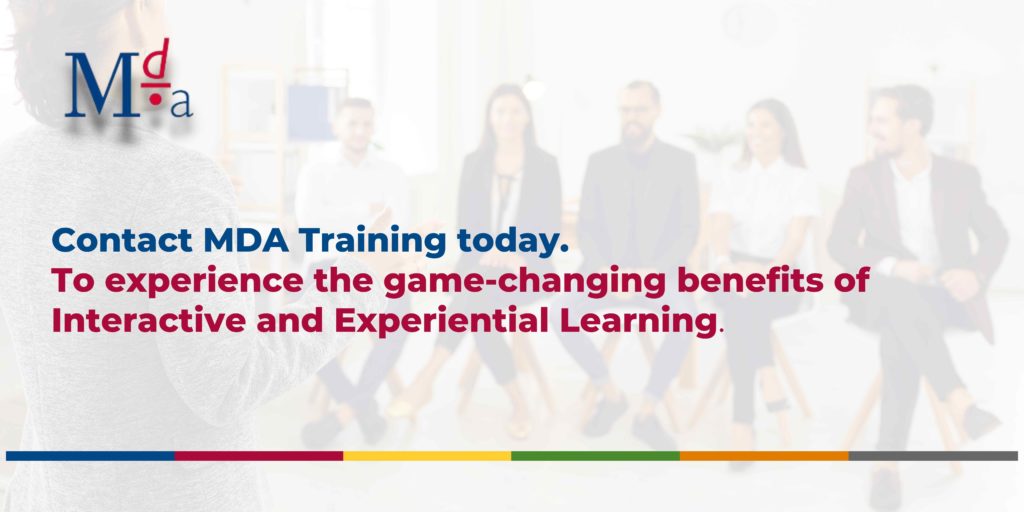In today’s fast-paced corporate world, employee engagement has emerged as a critical factor in the success of organisations. Engaged employees are more productive, innovative, and loyal, leading to increased profitability and sustained growth. While there are various methods to boost employee engagement, one approach that stands out as a game-changer is Interactive and Experiential Learning.
Understanding Employee Engagement
Before delving into the transformative power of Interactive and Experiential Learning, let’s first understand what employee engagement truly means. Employee engagement refers to the emotional commitment employees have towards their organisation. Engaged employees are passionate about their work, align with the company’s values, and actively contribute to its success.
On the other hand, disengaged employees are likely to be unmotivated, unproductive, and may even contemplate leaving the organisation. Hence, fostering employee engagement is crucial for businesses to thrive in the competitive landscape.
Challenges in Traditional Learning Approaches
Traditionally, employee training and development have relied on passive learning methods, such as lectures and presentations. While these approaches may impart knowledge, they often fail to inspire employees or enhance their skills effectively. Employees can easily disengage from such monotonous training sessions, leading to limited retention and poor application of acquired knowledge.
The Power of Interactive and Experiential Learning
Interactive and Experiential Learning introduces a refreshing paradigm shift in employee training. This approach emphasises active participation, hands-on experiences, and real-world simulations, making the learning process dynamic and engaging. Here’s why it can be a game-changer:
1. Enhanced Retention and Application
One of the most significant advantages of Interactive and Experiential Learning is its unparalleled ability to enhance retention and application of knowledge. Unlike traditional passive learning methods, where information is often forgotten shortly after being presented, interactive learning engages multiple senses and cognitive processes, making the learning experience more memorable and impactful.
1.1 Active Participation for Lasting Impact
In interactive learning sessions, employees are not just passive recipients of information; they become active participants in the learning process. By engaging in hands-on activities, problem-solving exercises, and role-playing scenarios, employees internalise the knowledge more effectively. Active participation stimulates the brain, creating stronger neural connections that lead to enhanced retention.
1.2 Contextual Learning for Real-World Application
Interactive and Experiential Learning provides employees with opportunities to apply their knowledge in real-world contexts. By simulating authentic work situations, employees gain practical experience and can immediately see the relevance of what they learn. This contextual learning is invaluable, as it bridges the gap between theory and practice, making it more likely that employees will apply their newly acquired skills in their daily tasks.
1.3 Learning by Doing: From Theory to Action
The famous proverb “Tell me, and I forget. Show me, and I remember. Involve me, and I understand” perfectly captures the essence of interactive learning. Instead of merely presenting information, this approach encourages employees to learn by doing. When individuals actively participate in problem-solving, decision-making, and hands-on tasks, they become more confident in their abilities, leading to improved application of knowledge in their professional roles.
1.4 Immediate Feedback for Continuous Improvement
One critical aspect of interactive learning is the provision of immediate feedback. Traditional learning methods often lack timely evaluation, leaving employees unsure of their progress and potential areas of improvement. With interactive learning, employees receive immediate feedback on their performance, allowing them to make adjustments and learn from their mistakes in real-time. This feedback loop promotes continuous improvement, helping employees reach their full potential faster.
1.5 Emotional Engagement and Long-Term Memory
Human emotions play a vital role in the learning process. Interactive and Experiential Learning evokes emotional engagement by creating enjoyable and meaningful experiences. When emotions are involved, the brain is more likely to retain information in long-term memory. As a result, employees are more likely to recall what they learned during interactive sessions, even months or years after the training took place.
1.6 Transfer of Learning to Challenging Situations
The ultimate goal of any learning program is to equip employees with the skills and knowledge needed to tackle real challenges in the workplace successfully. Interactive learning facilitates the transfer of learning to challenging situations. By providing employees with realistic scenarios and allowing them to practise problem-solving in a safe environment, they build the confidence and competence required to handle complex issues effectively.
2. Personalised Learning Journeys
Personalised learning has emerged as a cornerstone of modern education, and its application extends far beyond traditional classrooms. In the corporate world, personalised learning journeys are gaining momentum as a powerful tool to boost employee engagement, learning efficiency, and overall organisational performance.
2.1 The Power of Personalisation
The benefits of personalised learning journeys extend far beyond mere customisation. Here are some compelling reasons why this approach is a game-changer for employee engagement:
- Relevance and Meaningful Learning: Personalisation ensures that the content and activities align with the specific roles and responsibilities of each employee. As a result, employees perceive the learning as more relevant and meaningful, which enhances their motivation to actively engage with the materials.
- Flexible Learning Pace: Not all employees learn at the same pace. Some may grasp concepts quickly, while others may need more time for mastery. Personalised learning allows individuals to progress at their own speed, minimising feelings of pressure and frustration.
- Empowerment and Autonomy: When employees have control over their learning paths, they feel empowered and autonomous. This sense of ownership fosters a greater sense of responsibility for their growth and development.
- Targeted Skill Development: Personalised learning enables organisations to identify skill gaps in individual employees and address them with targeted training. This targeted approach ensures that the learning objectives align precisely with the desired skill development.
- Adapting to Diverse Learning Styles: Different employees have different learning preferences, such as visual, auditory, or kinesthetic. Personalised learning journeys accommodate these diverse styles, enhancing information retention and comprehension.
- Continuous Feedback and Support: Personalised learning platforms can provide real-time feedback to employees, guiding them through their learning journey. This constant support ensures that learners stay on track and receive assistance when needed.
3. Boosting Team Collaboration
In today’s interconnected and fast-paced business landscape, effective team collaboration has become a crucial driver of success for organisations. When employees collaborate seamlessly, ideas flow freely, problems are solved efficiently, and productivity soars. To achieve this level of teamwork, organisations must adopt strategies and foster a collaborative culture that empowers employees to work together harmoniously and cohesively towards common goals.
Team collaboration involves individuals from diverse backgrounds, skills, and expertise coming together to pool their talents and knowledge. By breaking down silos and encouraging open communication, collaboration enables teams to tackle complex challenges collectively and drive innovation.
Here are some key benefits of boosting team collaboration:
- Enhanced Problem-Solving: Collaborative teams bring together different perspectives and insights, leading to more comprehensive problem-solving. By leveraging the collective intelligence of the team, organisations can find creative and effective solutions to even the most complex issues.
- Increased Efficiency and Productivity: When employees work together cohesively, tasks are completed more efficiently, and projects progress smoothly. Collaborative environments foster streamlined workflows, reducing redundancies and enhancing overall productivity.
- Innovation and Creativity: Collaboration sparks creativity by encouraging the exchange of ideas and out-of-the-box thinking. Teams that collaborate openly are more likely to generate innovative solutions and capitalise on emerging opportunities.
- Heightened Employee Engagement: Engaged employees are more likely to be invested in their work and feel a stronger sense of purpose. Collaboration fosters a positive work environment, leading to higher levels of employee engagement and job satisfaction.
- Knowledge Sharing and Learning: When team members collaborate, they share their expertise and learn from each other. This continuous knowledge exchange enriches the team’s collective skills and capabilities.
4. Immediate Feedback and Improvement
Immediate feedback refers to the practice of providing performance feedback promptly after a task or project is completed. Unlike traditional feedback methods that occur sporadically during formal performance reviews, immediate feedback offers real-time insights into an employee’s strengths, areas for improvement, and overall progress.
Here are some compelling reasons why immediate feedback is a catalyst for growth and improvement:
- Relevance and Context: When feedback is delivered immediately, the context of the task or project is fresh in the employee’s mind. This relevance allows employees to connect feedback to specific actions, making it more impactful and actionable.
- Course Correction and Adaptation: Immediate feedback empowers employees to make timely course corrections. By addressing areas of improvement promptly, employees can adjust their approach and improve their performance in real-time.
- Employee Engagement and Motivation: Feedback is a powerful tool for employee engagement. Timely and constructive feedback shows employees that their efforts are noticed and valued, motivating them to strive for continuous improvement.
- Development of Growth Mindset: Immediate feedback nurtures a growth mindset within the organisation. Employees become more receptive to feedback, viewing it as an opportunity for learning and development, rather than criticism.
- Building Trust and Open Communication: Frequent and timely feedback builds trust between employees and their managers. It encourages open communication and transparency, as employees feel comfortable seeking guidance and discussing challenges.
5. Gamification for Fun and Learning
In recent years, gamification has emerged as a transformative approach to enhance engagement and learning experiences. By integrating game elements into non-game contexts, organisations can create a fun and immersive learning environment that motivates employees to actively participate in the learning process.
5.1 The Power of Gamification in Learning
Gamification capitalises on basic human desires, such as achievement, recognition, and a sense of progress, to drive engagement and motivation. Here are some ways in which gamification enhances learning:
- Intrinsic Motivation: By tapping into the intrinsic motivation of individuals, gamification sparks enthusiasm for learning. The satisfaction of completing challenges and earning rewards serves as its own motivator, keeping learners engaged and eager to progress.
- Immediate Feedback: Gamification provides real-time feedback on learners’ performance, giving them instant gratification for their accomplishments or insights into areas for improvement. This immediate feedback loop fosters continuous learning and improvement.
- Healthy Competition: Incorporating elements of competition can create a sense of friendly rivalry among learners, encouraging them to put forth their best effort and strive for excellence.
- Learning by Doing: Gamification emphasises learning by doing, allowing learners to apply newly acquired knowledge in simulated scenarios. This hands-on approach facilitates better retention and application of skills.
- Customised Learning Paths: Gamification often allows for personalised learning journeys. Learners can choose their paths, progressing at their own pace and focusing on topics that interest them, making the learning experience more relevant and enjoyable.
5.2 Gamification Elements for Effective Learning
To maximise the impact of gamification in learning, organisations can utilise various game elements strategically:
1. Points and Rewards
Assign points to learners for completing tasks, achieving milestones, or demonstrating specific skills. These points can be used to unlock rewards or compete for leaderboard positions, incentivizing learners to stay engaged and strive for excellence.
2. Badges and Achievements
Awarding badges and achievements for mastering specific skills or completing learning modules adds an element of accomplishment. Badges act as tangible representations of progress and accomplishments, boosting learners’ confidence and motivating them to pursue further challenges.
3. Progress Tracking
Providing learners with visual progress trackers helps them see their advancement through the learning journey. This transparency keeps learners aware of their development and encourages them to complete the entire learning program.
4. Quizzes and Challenges
Incorporate quizzes, challenges, and interactive activities that require learners to apply their knowledge in various scenarios. These elements reinforce learning and provide immediate feedback on performance.
5. Storytelling and Narratives
Integrate storytelling and narratives into the learning experience to make it more engaging and relatable. Narratives can immerse learners in real-world situations, making learning content more memorable and applicable.
6. Adaptability to Modern Workforce
The modern workforce, primarily comprising millennials and Gen Z, seeks engaging and meaningful experiences in all aspects of life, including learning. Interactive and Experiential Learning aligns with their preferences and expectations, making it a perfect fit for the current generation of employees.
6.1 Key Aspects of Adaptability
Adaptability to the modern workforce involves addressing several key aspects to attract, retain, and engage talent effectively:
1. Flexible Work Arrangements
Modern employees value flexibility in their work arrangements. Organisations should embrace remote work options, flexible working hours, and hybrid work models to accommodate different lifestyle preferences and maximise productivity.
2. Emphasis on Work-Life Integration
Work-life integration has replaced the traditional work-life balance concept. Modern employees seek harmony between their personal and professional lives, and organisations must support this integration by promoting employee well-being and providing resources for work-life harmony.
3. Continuous Learning and Development
The modern workforce craves opportunities for continuous learning and skill development. Organisations must offer robust learning and development programs that allow employees to upskill, reskill, and stay relevant in a rapidly changing job market.
4. Embrace Technology
Technology plays a central role in the modern workforce. Organisations must invest in cutting-edge tools and digital infrastructure to streamline work processes, enhance collaboration, and support remote work capabilities.
5. Diversity, Inclusion, and Belonging
Inclusive workplaces that celebrate diversity and foster a sense of belonging are essential to attracting and retaining talent from different backgrounds. Organisations should prioritise diversity and inclusion efforts to create a supportive and welcoming work environment for all employees.
6. Agile and Decentralised Decision-Making
The modern workforce values autonomy and the ability to contribute to decision-making processes. Implementing agile methodologies and encouraging decentralised decision-making empowers employees and boosts their engagement.
Implementing Interactive and Experiential Learning
Now that we understand the benefits of Interactive and Experiential Learning, let’s explore how organisations can effectively implement this game-changing approach:
1. Identify Learning Objectives
Begin by defining clear learning objectives aligned with your organisation’s overall goals. Identify the skills and knowledge gaps that need to be addressed and determine the desired outcomes of the learning program.
2. Curate Engaging Content
Develop interactive learning content that stimulates the minds of employees. Utilise multimedia elements like videos, quizzes, and simulations to keep participants engaged and excited about the learning process.
3. Utilise Technology
Leverage modern learning technologies and platforms to deliver interactive content efficiently. Online learning portals, virtual reality simulations, and mobile learning apps can enhance accessibility and engagement.
4. Encourage Continuous Learning
Employee engagement is not a one-time event but an ongoing journey. Encourage continuous learning and skill development through regular interactive sessions, workshops, and mentorship programs.
5. Measure Success Metrics
Monitor the effectiveness of the Interactive and Experiential Learning program by tracking key performance metrics. Analyse employee feedback, performance improvements, and overall business impact to refine and optimise the learning experience continually.
What’s Next?
MDA Training offers a revolutionary approach to enhance employee engagement and elevate organisational performance through Interactive and Experiential Learning. By actively involving employees in the learning process and creating immersive experiences, MDA Training helps organisations unleash the true potential of their workforce.
Engaged employees are essential for a thriving business, and MDA Training understands the importance of investing in their growth and development through interactive learning. This approach yields long-term benefits, positively impacting your organisation’s culture, productivity, and bottom line.
Embracing this transformative learning approach from MDA Training can lead to a significant shift in your organisation’s dynamics. It’s not just about acquiring new knowledge; it’s about fostering a culture of continuous learning and growth.



















